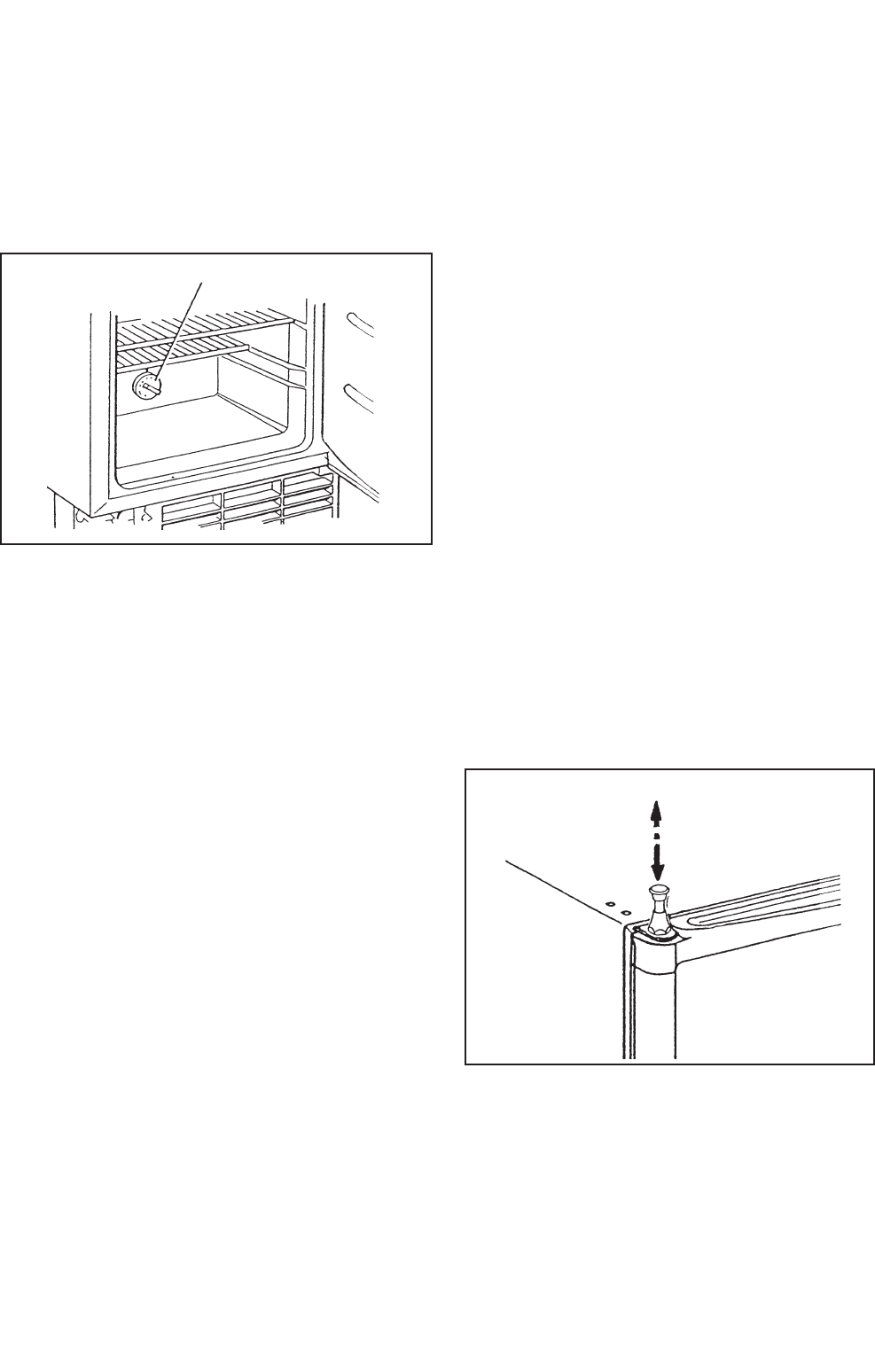
10
17. Electric Operation (230V a.c.) Model RM123 only.
IMPORTANT: Before connecting any mains voltage electricity supply
to a caravan, always make certain that the supply has an effective
earth connection and that polarity is correct in relation to the mains
voltage wiring in the caravan. For safety, it is essential, particularly for
overseas use, to check for earth continuity and correct polarity of the
connected supply. (There are different makes of proprietary polarity
and Earth Continuity monitors on the market for this purpose).
To start the refrigerator on mains voltage electricity,
see that the gas control knob (4, fig. 14a), the igniter switch (5, fig.
14a), and the 12V supply are off. Connect the refrigerator to the
electricity supply socket and switch on. Turn the electric thermostat
dial (6, fig. 15) so that setting 3 or 4 is against the indicator mark.
FIG. 15 (6)
17a. 12 VOLT ELECTRIC OPERATION
When the caravan is on tow, it is recommended that the refrigerator
is operated electrically, i.e. from the 12V battery in the towing vehicle,
and not by means of bottled gas.
It is important to understand that 12V operation is intended only to be
used whilst the car engine is running and charging the battery, and
for short periods when at rest, otherwise the battery may be
discharged to a point where it will not re-start the engine. When the
caravan is at rest for more than a relatively short period, say about
half an hour, the caravan should be levelled, the refrigerator
disconnected from the 12V supply, and, if required, started up on
bottled gas or mains electricity.
For operation on 12V, the boiler of the cooling unit is fitted with an 75
watts heating element (2, fig. 10), connected to a two way terminal
block (3) at the back of the refrigerator, 12V operation is not
thermostatically controlled therefore the cooling unit will operate all
the time the refrigerator is connect to the 12V supply. (As 12V
operation is intended for use only while the caravan is on tow, over-
cooling is unlikely because of the comparatively short time involved.
If overcooling does occur during extended towing periods, the
refrigerator may be disconnected periodically as experience proves
necessary).
The wiring in the car and caravan to supply the refrigerator from the
main battery in the car should have been installed in accordance with
item 10 on page 6 of the installation section.
To use the refrigerator, on 12V, check that the gas is turned off,
then connect together the plug(s) and socket(s) fitted during
installation, and switch on any switches in the circuit to the
refrigerator.
Note:-Before operating the refrigerator on 12V, it should be pre-
cooled, together with its contents, by running it on bottled gas for a
few before changing over to 12V and starting on a journey.
18. TEMPERATURE REGULATION
After starting the refrigerator, it will take about an hour before the ice-
tray shelf shows signs of cooling.
The gas control knob (4, fig. 14) has four positions, marked 'Off', and
3, 2 and 1, representing three sizes of flame- Maximum, Medium and
Minimum. The amount of cooling produced in the refrigerator will
depend on the size of flame used.
It is preferable to start the refrigerator with the control knob set at
the Maximum flame position (No 3). After an hour or so, it may be
turned to the Medium (No 2) or Minimum (No 1) positions, to
provide the cooling required under the prevailing conditions.
In warm weather, or with a heavy food load, or frequent door
openings, the Medium or Maximum position will usually be
needed, but, in cold weather it may only be necessary to use the
Minimum flame position.
Remember to alter the setting, as necessary, if there is an
appreciable change in room temperature or conditions of use.
When operating on mains electricity, the refrigerator temperature
is thermostatically controlled ant the thermostat dial (6, fig. 15)
should be set with No. 3 or 4 against the indicator mark. Suitable
temperatures will then be maintained in the fridge for general use
but, in hot weather, or if more cooling is required, turn the dial to
a higher number. For less cooling, turn it to a lower number.
19. STORING FOOD IN THE REFRIGERATOR
Four half-depth shelves are provided. Two can be used together
to form a full size shelf (with the rear one reversed so that its
raised edge is at the back), or they can be used separately in the
four locations in the lining to leave space for bottles at the front.
To prevent drying out and the transfer of flavours from one food
to another, always store foods in covered containers or plastic
bags. When 'on the move', crumpled pieces of clean paper may
be wedged (temporarily) between the various items to retain
them.
Never put hot food into the refrigerator.
Remember to engage the travel catch when the caravan is to be
on tow (see next item).
20. ICE-MAKING
Fill the ice-tray with water to within 3/16 inch (5 mm) from the top,
and place it on its shelf inside the refrigerator. When the ice has
formed, the tray can be released fron the shelf simply by lifting
one corner.
When operating on gas, ice will be made more quickly if the
control knob (4, fig. 14) is temporarily turned to the Maximum
flame position (No. 3).
21. TRAVEL CATCH
The travel catch (fig. 16) is to keep the refrigerator door securely
closed when the vehicle is on the move. Remember to push the
catch down so that its lower end fully engages the plastic bush in
the top of the door, before moving off.
Fig. 15
Fig. 16
6














